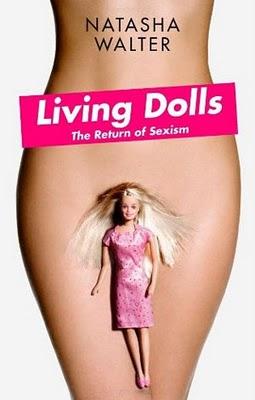Living Dolls: The Return of Sexism

Shhh, stop and listen for a moment. Listen to the radio, to TV ads, to government policy, to toy stores, to popular magazines, and (OMG) to "science." If you are a fan of equality and freedom of choice, you may want to listen up. And when you’ve had your fill of propaganda it may just be time to shout, "Sexual discrimination never died!"
Natasha Walter’s latest book, Living Dolls, uses an array of examples to outline perfectly how un-free "liberated" women really are. There is a momentum building in the men vs. women camp again, and this isn’t just old fashioned sexism where women are fine so long as they knew their place. This is super sexism, where women are best not looking too real (for fear of causing offense), and where being like Barbie is the ideal. Living Dolls strengthens this premise at every turn.
The book starts with a trip to a multilevel toy shop in London where one can take the elevator to a floor "for girls" that is all decked out in that colour that we females find irresistible: pink. If it wasn’t clear before this floor spelled it out, little girls like to play dress-up as princesses, homemakers, nurses, and brides, and play with baby dolls and other soft, squishy games. Of course, girls do like all of this. (Being the mother of two daughters, I have waded through my fair share of pink landscapes and lamented the fact that one of my daughters wore nothing but pink for two years of her pre-school life before going to real school turned her into a goth. Black is now her favourite); however, girls also like doing other things. They like getting dirty and exploring, climbing trees, inventing stuff, solving puzzles, and smashing things up. In my experience, when free to choose girls and boys end up playing pretty similar games until gender is made an issue—and that’s the problem. Sexism starts early and it seems that in today’s world you are either all boy or all girl; blurring that line can spell social and emotional disaster.
Sound a bit dramatic? Well this is only the beginning of the book, but I can attest to the jeering that happens when a girl admits to preferring Legos over Barbies or tree climbing over playing house. Is it any wonder that when we create planet boy and planet girl in kindergarten that we need a manual to help us decode those beings from Mars or Venus once when we hit puberty?
I was fascinated by the part of the book that reviewed a series of research projects that claim to have found differences between the male and female brains. Walter shows how these experiments are rife with bias. This section makes for fascinating, and somewhat challenging, reading. I have often fallen into the ‘gender brain’ trap when describing people I know or situations that I’ve observed. It may be natural, but that doesn’t mean it’s only biological! Our brains may or may not have the same capabilities, but we wouldn't know because our society and social interactions thrive on nurturing difference. It’s a crazy dichotomy that we are creating.
I always enjoy reading books that make me want to go out and change the world, and Living Dolls certainly does that. It makes many valid and scientifically rigorous points. Read the book and challenge stereotypes. I didn’t come out of a box, and I’m not going to make one my home now. So there!
Excerpted from Realize Beauty